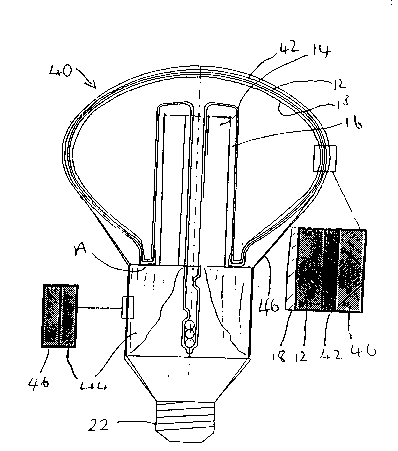Some of the information on this Web page has been provided by external sources. The Government of Canada is not responsible for the accuracy, reliability or currency of the information supplied by external sources. Users wishing to rely upon this information should consult directly with the source of the information. Content provided by external sources is not subject to official languages, privacy and accessibility requirements.
Any discrepancies in the text and image of the Claims and Abstract are due to differing posting times. Text of the Claims and Abstract are posted:
| (12) Patent Application: | (11) CA 2188072 |
|---|---|
| (54) English Title: | ELECTRODELESS FLUORESCENT LAMP |
| (54) French Title: | LAMPE FLUORESCENTE SANS ELECTRODE |
| Status: | Deemed Abandoned and Beyond the Period of Reinstatement - Pending Response to Notice of Disregarded Communication |
| (51) International Patent Classification (IPC): |
|
|---|---|
| (72) Inventors : |
|
| (73) Owners : |
|
| (71) Applicants : |
|
| (74) Agent: | CRAIG WILSONWILSON, CRAIG |
| (74) Associate agent: | |
| (45) Issued: | |
| (22) Filed Date: | 1996-10-17 |
| (41) Open to Public Inspection: | 1997-04-19 |
| Examination requested: | 2001-10-04 |
| Availability of licence: | N/A |
| Dedicated to the Public: | N/A |
| (25) Language of filing: | English |
| Patent Cooperation Treaty (PCT): | No |
|---|
| (30) Application Priority Data: | ||||||
|---|---|---|---|---|---|---|
|
An electrodeless fluorescent lamp includes a glass
envelope 12 at least of portion of the outer surface of
the glass envelope, being coated with an electrically
conductive layer 42, and a housing 44 made of metal which
makes electrical contact with the electrically
conductive layer 42, the bulb 12 and housing 44 being
covered at least partially by a one-piece insulating
sleeve 46.
Note: Claims are shown in the official language in which they were submitted.
Note: Descriptions are shown in the official language in which they were submitted.

2024-08-01:As part of the Next Generation Patents (NGP) transition, the Canadian Patents Database (CPD) now contains a more detailed Event History, which replicates the Event Log of our new back-office solution.
Please note that "Inactive:" events refers to events no longer in use in our new back-office solution.
For a clearer understanding of the status of the application/patent presented on this page, the site Disclaimer , as well as the definitions for Patent , Event History , Maintenance Fee and Payment History should be consulted.
| Description | Date |
|---|---|
| Inactive: IPC from MCD | 2006-03-12 |
| Application Not Reinstated by Deadline | 2003-10-17 |
| Time Limit for Reversal Expired | 2003-10-17 |
| Deemed Abandoned - Failure to Respond to Maintenance Fee Notice | 2002-10-17 |
| Inactive: Status info is complete as of Log entry date | 2001-10-31 |
| Inactive: Application prosecuted on TS as of Log entry date | 2001-10-31 |
| Letter Sent | 2001-10-31 |
| Request for Examination Requirements Determined Compliant | 2001-10-04 |
| Amendment Received - Voluntary Amendment | 2001-10-04 |
| All Requirements for Examination Determined Compliant | 2001-10-04 |
| Application Published (Open to Public Inspection) | 1997-04-19 |
| Abandonment Date | Reason | Reinstatement Date |
|---|---|---|
| 2002-10-17 |
The last payment was received on 2001-09-27
Note : If the full payment has not been received on or before the date indicated, a further fee may be required which may be one of the following
Patent fees are adjusted on the 1st of January every year. The amounts above are the current amounts if received by December 31 of the current year.
Please refer to the CIPO
Patent Fees
web page to see all current fee amounts.
| Fee Type | Anniversary Year | Due Date | Paid Date |
|---|---|---|---|
| MF (application, 2nd anniv.) - standard | 02 | 1998-10-19 | 1998-09-16 |
| MF (application, 3rd anniv.) - standard | 03 | 1999-10-18 | 1999-09-24 |
| MF (application, 4th anniv.) - standard | 04 | 2000-10-17 | 2000-09-28 |
| MF (application, 5th anniv.) - standard | 05 | 2001-10-17 | 2001-09-27 |
| Request for examination - standard | 2001-10-04 |
Note: Records showing the ownership history in alphabetical order.
| Current Owners on Record |
|---|
| HANIF MAHOMED GIRACH |
| Past Owners on Record |
|---|
| None |